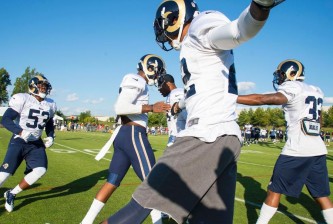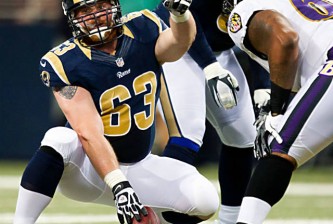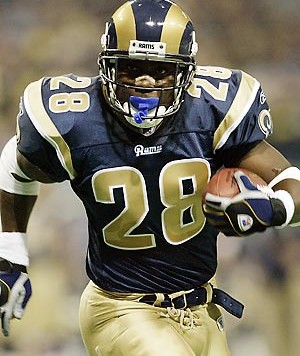The St. Louis Rams will be donning their throwback uniforms in tribute to Marshall Faulk, and contemplating a quest familiar to the beginning of his days here: taking an unknown quarterback into battle against a superior foe.
To me, the linchpin of the Rams success in those years wasn’t Kurt Warner, though he was obviously a catalyst; not Bruce or Holt, though they were as talented a tandem as you could ask for; the key to making that Martz hybrid of Sid Gilman’s offense work was the multifaceted threat of Marshall Faulk out of the backfield. Defenses could adjust to take away the vertical threats of the wideouts, as Tampa did with their version of the Cover Two. But no defensive scheme could take Faulk out of the game plan, because he – like the Rams – could beat you in so many ways.
Faulk was rewarded for his record-shattering play by being called up to Canton to have his bust enshrined in Pro Football’s Hall of Fame, one of the elite few to be honored in their first year of eligibility. Frankly, this surprised no one who had ever seen him play. We put together a massive compendium of fans’ favorite Marshall Faulk memories back in August, and the list is as impressive in its length as in its variety.
We see Faulk now, as highly polished in his NFL Network studio as his bronzed likeness in Canton, reflecting the greatness of his on-field success. It is all the more fascinating, then, to look back at where he came from. I went looking for more Faulk tribute videos, and found this one from WWLV TV in New Orleans, profiling the rain-soaked, chewed-up practice field he began his playing career on.
The video dates back to 1991, Faulk’s first year at San Diego State, when it became apparent that a local high school hero might have greatness writ within him. It also includes a stunning detail: that Faulk was heavily recruited out of high school as a defensive player.
Faulk paid tribute to that field, and to the coach that brought the most out of him, in his Hall of Fame enshrinement speech.
See, this story is deep. I’m from the Ninth Ward. That is the Desire Projects in New Orleans, Louisiana. Many don’t make it out of there. And even though there were drugs and violence, I never wanted to take drugs or die young.
Instead, I channeled every ounce of energy that I had into sports. I played baseball, basketball, football, I ran track. Before whatever reason at George Washington Carver Senior High, I thought basketball was going to be my way out, and ultimately my destiny.
But in making that decision, it didn’t stop me. I continued to compete in all sports. Then one day a very special man to me, my high school coach, Wayne Reese, he’s here tonight. Where you at, Coach Reese? I know your family’s here. You brought a lot of people up from New Orleans. He pulled me aside and asked me a question, a simple question. He asked me, how many 5’9″ shooting guards do you see playing in the NBA? You see, I felt like I was a scorer.
Coach Reese had seen me compete in every sport and was aware of my work ethic. Coach was trying to explain to me how other sports would help me, but football could take me places.
Coach, I want to tell you, you taught me responsibility. You taught me that everything in life costs something. It simply depends on what I was willing to spend on it coach, thank you for helping me choose a university. You explained to me the importance of choosing a school that was going to challenge me academically as well as assist and molding me into the best football player that I could be.
You helped me understand how focusing on what was important, it was necessary. It was not necessary the size of the institution, but the quality of men in the program.
As the Rams celebrate Faulk today, as the first member (of many to come, we hope) of the St Louis branch of this storied franchise to enter the Hall, it’s worth looking back at his time on those muddy fields in New Orleans’ poorest neighborhoods that helped forge Faulk into the man and the player he became.























